by Steven Bonta
for shanghaibirding.com

In July 2021 I made a 10-day trip to the mountains and Tibetan Plateau region of western Sichuan. I was with Kai Pflug, a bird photographer and longtime China resident from Shanghai. Kai arrived several days earlier and had early success birding around Wolong and Balang Mountain. I had to wait until the evening of June 30 to fly to Chengdu, where I arrived at midnight. I headed directly to Wolong, a village in the mountains, about three hours from the city. My driver and guide, Phillip, with Chengdu-based Alpine Birding, was the same guide with whom I toured Wolong and parts of southern Sichuan in October 2020. Our itinerary for this trip called for several days at Wolong and nearby Balangshan before departing northwest into the deeper mountains and Sichuan portion of the Tibetan Plateau around Ruoergai. We arrived at the hotel in Wolong at 3:30 a.m., and since we needed to depart for birding at 4 a.m., I did not sleep at all that night.
Day 1: In the predawn darkness we left Wolong and drove up the tortuous mountain road to the famous tunnel birding area (30.877921, 102.966226). This is a stretch of abandoned highway not far below treeline on Balang Mountain where traffic has been rerouted through a tunnel. The abandoned road makes an ideal vantage point and is the best place in China to observe Chinese Monal, one of the world’s most beautiful pheasants. Despite the drizzling rain, we managed to log many key species, among them Snow Pigeon, Temminck’s Tragopan, White Eared Pheasant, Sichuan Thrush, and Grey-headed Bullfinch. We had a host of leaf warblers, predominant among which were Large-billed Leaf Warbler and Greenish Warbler. Also present were several of China’s glorious rosefinch species, among them Common Rosefinch, Dark-breasted Rosefinch, Chinese White-browed Rosefinch, and Crimson-browed Finch. Mammals were also in evidence. We spotted a couple of Tufted Deer and a Chinese Goral browsing on the slopes. No Chinese Monal appeared.
Mid-morning we drove higher, to the high pass (30.910806, 102.894694) far above treeline at an elevation of more than 4500 m (14,760 ft.). The weather did not improve until early in the afternoon, but the birds did not seem to mind. We spotted a family of Tibetan Snowcock on the slope above the road, not more than 50 meters distant. For me the prize that afternoon was three brilliant blue male Grandala, hardy birds that breed above treeline on the Tibetan Plateau. I have never seen a bird quite as vividly blue as this creature. Also abundant on the higher slopes were Brandt’s Mountain Finch and Plain Mountain Finch, confiding little birds with sparrow-like plumage. In the dwarf rhododendron we found singing Chinese Rubythroat, a sublimely beautiful bird with more striking coloration than its more familiar (to Western birders) cousin, Siberian Rubythroat. We also enjoyed sightings of other colorful birds such as Grey-headed Bullfinch and Blue-fronted Redstart. Because of the rain and fog, we saw no mountain raptors, although a few rain-soaked Red-billed Chough were around. The alpine slopes were carpeted with brilliant wildflowers, among them alpine poppies, rhododendron, furze, asters, various tiny lilies, and gentians.
Eventually, the wet, cold, and persistent fog and drizzle drove us to lower elevations, specifically to Lama Monastery (31.029363, 103.166572) outside Wolong. At an elevation of 2230 m (7,320 ft.), the monastery is much lower than the high country we had just left. In the fall of 2020 I had seen Golden Pheasant and many other birds at the monastery. This time our goal was much more modest: to see Slaty Bunting, a China endemic that resembles an American “Slate-colored” Junco. I got a good view of several of these shy birds, while noting that most of the other birdlife I had seen before was absent. I did, however, note my first Himalayan Vulture and Mrs. Gould’s Sunbird of the trip. Himalayan Vulture are condor-sized vultures common across the Himalayas and Tibetan Plateau, while Mrs. Gould’s Sunbird are gorgeous little long-tailed jewels with wings, one of the most spectacular of the sunbird species. The Lama Monastery forests were surprisingly quiet, aside from abundant Claudia’s Leaf Warbler and Sichuan Leaf Warbler, a small flock of White-collared Yuhina, and ever-inquisitive Red-billed Blue Magpie.
With a couple hours of daylight left, we explored other patches of forest around Wolong, finding several beautiful Indian Blue Robin, a species I had seen in Sri Lanka but never in China. We also picked up the usual run of local species fond of secondary scrub and village areas, such as Chinese Babax, Grey Bush Chat, White-browed Laughingthrush, and Brown-breasted Bulbul.
We returned to our hotel and a sumptuous dinner, after which I slept soundly until 4 am.
Day 2: We once again left early in the morning and this time were pleasantly surprised that the rain and fog had abated. Once again we waited in vain for a Chinese Monal to appear at the tunnel area. Koklass Pheasant called in the forest below at first light. On the high pass the sun came out, and we saw more and more birds. My first Bearded Vulture of the trip circled overhead, and families of Tibetan Snowcock seemed to be everywhere in the early morning, including right along the roadside. At the area where we had found Chinese Rubythroat the previous day, we now found several luminous White-browed Tit-warbler, a rainbow-colored bushtit species, and one of our main goals of the trip. Conspicuous at the same spot were Rufous-breasted Accentor, while on the more desolate slopes even higher up were Alpine Accentor. We also saw several Grey-headed Bullfinch and Himalayan Marmot. Among the conifers at the very edge of the treeline, we found in abundance passerines, among them Hume’s Warbler, Tickell’s Leaf Warbler Phylloscopus affinis occisinensis, Giant Laughingthrush, Blue-fronted Redstart, and unusual high-elevation occurrences of Long-tailed Minivet and Ashy Drongo. After several hours in the high country above 4000 m (13,120 ft.), we descended to a rocky canyon, where a few days earlier someone had spotted Wallcreeper. Reaching the spot, a steep-walled, rocky canyon beside a rushing alpine river, we soon found a pair of Wallcreeper working their way over a pitted cliff face, fluttering and probing. That was a lifer I had awaited for more than 40 years. Occasional Salim Ali’s Swift rocketed down the canyon while we watched the wallcreepers for almost an hour. As as we returned to the car, serenading us from dense foliage was an Aberrant Bush Warbler.
Day 3: Again to the tunnel and then the high pass, where we observed another Bearded Vulture and two Himalayan Vulture, in addition to a small flock of White Eared Pheasant and the usual parade of rosefinches, mountain finches, redstarts, accentors, and laughingthrushes. We also saw a White-throated Dipper. The star of the show for that day was the peerless Firethroat, an exquisitely plumaged Chinese breeding endemic with a vividly colored throat. The songster was singing from a dense thicket halfway down the mountain, and we waited a long while before it alighted on a visible perch. With the weather having improved and it now being the weekend, the high slopes swarmed with noisy day trippers, most of whom were picking flowers and plants like a plague of locusts. Birding amid the glut, we turned up a Yellow-bellied Bush Warbler and a flock of White-collared Yuhina. Further down, we failed to re-find Wallcreeper. At Lama Monastery we picked up a flock of Short-billed Minivet.
Day 4: In the morning, we ascended again to the high pass area, seeing for the last time the jaw-dropping assortment of rosefinches, snowcocks, redstarts, laughingthrushes, tit-warblers, mountain finches, and rubythroats. We then embarked on an arduous drive several hours long deeper onto the Tibetan Plateau. Our destination was Mengbishan (31.7151262, 102.3168788), another forested mountain with much birding potential. We arrived in the afternoon, exhausted from bashing, smashing, and crashing our way through thousands of potholes, negotiating dozens of construction delays, and avoiding the homicidal instincts of other drivers. Here were none of the traffic cameras and other surveillance typical of Chinese cities and modern roadways, and so drivers seemed to have no scruples about killing themselves or destroying their cars. Along the long road, in the deep mountain gorges we stopped to observe interesting birds, among them Blue Rock Thrush, Eurasian Crag Martin, Hill Pigeon, and an exquisite Three-banded Rosefinch.
Arriving at the high pass over Mengbishan, which is slightly lower (around 4000 m or 13,000 ft.) than Balangshan, I immediately spotted Golden Eagle, Bearded Vulture, and several Himalayan Vulture all wheeling about over the bare mountainside. It was a beautiful sunny afternoon. We spent the rest of the day looking for birds in the high conifer forests. The results were spectacular. We had not been long at one spot along the dusty mountain road when a pair of brilliantly colored Crested Tit-warbler appeared out of the dense trees and foraged in the spruce boughs only yards away. Crested Tit-warbler is another vividly colored alpine bushtit, even more striking than White-browed Tit-warbler. After watching them awhile with Kai and the Chinese guides, I hiked alone down the mountain road, hoping to find the rare Sichuan Jay. I was unsuccessful, but I did get excellent looks at two of China’s three montane yellow-and-black grosbeak species, Collared Grosbeak and White-winged Grosbeak. I also saw Hodgson’s Treecreeper, as well as the usual suite of leaf warblers (three species) and redstarts (five). At day’s end we drove down to the foot of the mountain and checked into a hotel in a touristy Tibetan village.
Day 5: The next morning we awoke to pouring rain. We made our way back up Mengbishan, hoping for more views of tit-warblers and possibly local pheasant species. Sure enough, on the way up the mountain, we encountered a bold male White Eared Pheasant, which showed little fear of us as it paced in the middle of the road. A little further up, a Verreaux’s Monal-Partridge was foraging on the road. Returning to the tit-warbler spot, we were rewarded with a return appearance by the two Crested Tit-warbler. I saw a pair of Tufted Deer, a Red Crossbill, a Grey Crested Tit, and several of the gorgeous Three-banded Rosefinch—but again, no Sichuan Jay.
We spent all day in the forest. As our access was mostly along the pocked and pitted road that winds over the pass and then coils down through the conifer forest, we had to endure noisy trucks banging past too close for comfort. The ever-diligent Chinese are building a tunnel through the mountain at its base, however, so most traffic will soon be diverted through it (we hope), and the remaining mountain road will become a quiet afterthought mostly fit for wildlife viewing, like the tunnel road at Balangshan.
Day 6: We left before dawn and began driving from Mengbishan ever deeper onto the Tibetan Plateau. I soon began seeing White-backed Thrush, also known as Kessler’s Thrush. These striking thrushes seem to occur only in a very specific slice of habitat between mountain and open plateau; once we got into the real grasslands, they disappeared.
The grasslands of the Tibetan Plateau in this area were more lush than those above Kangding, in southern Sichuan, that I had visited the previous fall. They also held different wildlife. Near a small airport, we spotted the first of many groups of Black-necked Crane, grazing in a wet meadow with a herd of yaks. We saw huge numbers of Oriental Skylark; the air was abuzz with them everywhere we stopped. We occasionally saw, perched on telephone wires and fences, Little Owl, the same diurnal owl species that represents the goddess Athena thousands of miles to the west. We stopped to explore a large expanse of meadow that reached over to a bluff and a wooded canyon. As soon as we got out of the car, a pair of Eurasian Hoopoe flew off. Approaching the trees, we saw for the first time Plain Laughingthrush, the large, thrasher-like laughingthrush of northern China. A huge Eurasian Eagle-Owl, which had been hiding in the trees, flew in front of us and disappeared over the bluff. Beating our way upslope in a failed attempt to re-find the owl, we found more of the enchanting White-browed Tit-warbler as well as several deer, either White-lipped or Red.
At another roadside stop we found Godlewski’s Bunting and Yellow-streaked Warbler, and we finally got a good look at the secretive White-bellied Redstart. When we stopped for lunch, we shared our space with large numbers of Azure-winged Magpie, a few Black-rumped Magpie (another Tibetan Plateau endemic), and a large flock of Daurian Jackdaw. Nearby was a large monastery or nunnery. I nearly scared to death a nun who was walking around the road when I stepped out of the bushes where I had been birding.
Near the crossroads town of Waqie (33.1253892, 102.6190738) we found many marvelous new birds, among them Pale Martin, Rock Sparrow, Hume’s Short-toed Lark, Twite, Chinese Grey Shrike, and several glowing Citrine Wagtail. In the wetlands we also tallied at least 7 more Black-necked Crane.
Arriving in the Ruoergai area, we went into the rolling hills of a very high pass. Our target was Przevalski’s Pinktail, also known as Przevalski’s Finch, the sole member of a family that diverged from finches and buntings before the latter two diverged from one another. Here the air was very thin (we were between 14,000–15,000 ft. or 4270–4570 m), and the horseflies, having an ample supply of yak blood, swarmed. Soon after we got out of the car, I saw my first Ground Tit, tan, meadowlark-like birds formerly assigned to the crow family. They were mingling with Plateau Pika, which had formed a large community similar to a Prairie Dog town (and are abundant all over the Plateau). Hiking into the surrounding hills, I saw many White-browed Tit. These birds have a white stripe above the eye and purplish-grey coloration. I also saw a few Horned Lark, a lot of Siberian Stonechat and Black Redstart, even a colorful Tibetan Partridge—but no pinktails. Finally, sick of the extreme sun and the horseflies, I made my way back to the car and struck up a conversation with Phillip and a couple of Amdo nomad herdsmen who had pastured their yaks nearby. The Amdo nomads are friendly in a quiet and self-effacing way, and I regretted not having the chance to get to know them better. Their yurts dot the grassland. Some of them have replaced their horses with motorbikes, but their lifestyle seems largely unaltered by modernity.
Just then, Shay, our other guide, indicated he had finally found some pinktails. Kai and I climbed up a slope to see them. They struck me as being somewhat like rosefinches with unexpectedly long, pink tails that glowed in the rays of the afternoon sun. I was intrigued by the name and impressed by the beauty of these mysterious birds.
Driving toward the town of Ruoergai, we found a charnel pit along the road where yak remains were dumped. It had attracted a sizable crowd of Himalayan Vulture, which cavorted and perched on a hillside right above us, unafraid of us.
At dusk we arrived in Ruoergai (33.5758599, 102.9611781) and checked into another well-appointed Tibetan-style hotel. After a sumptuous supper, I had trouble getting to sleep, partly from excitement and partly from the lack of oxygen. It was the only problem I had on that trip with oxygen, despite spending many hours hiking and climbing above treeline.
Day 7: We left early in the morning for Baxi Forest, a vast alpine woodland near Ruoergai. We were searching for Snowy-cheeked Laughingthrush, Black Woodpecker, Blue Eared Pheasant, and Crested Tit-warbler. The weather was cold and overcast at first, and we got our pants and shoes soaked hiking up a yak trail into a valley. There were more White-lipped or Red Deer in the area, as well as wild boars. At one point, I walked right up to a huge black boar grazing in the brush, apparently unaware of my presence, and I asked it whether it was wild or domestic. It raised its head and snorted in surprise, its black, matted hair allaying any doubts, and bounded off into the brush.
The best bird of the day was the attractive Slaty-backed Flycatcher, which in Baxi was easy to see. We also easily found Snowy-cheeked Laughingthrush (although they were hard to see well skulking deep in heavy brush), as well as breeding Siberian Rubythroat, a species only recently acknowledged to breed in this area. We also enjoyed a visit from a Przevalski’s Nuthatch, a species that except for its deep rufous breast and belly closely resembles the American White-breasted Nuthatch. Red Crossbill and Long-tailed Minivet were also common here, as well as Hodgson’s Treecreeper, Grey-headed Bullfinch, and Chinese White-browed Rosefinch. Also common was Giant Laughingthrush, one of the most impressive of the Chinese laughingthrushes, and seemingly abundant everywhere in western Sichuan in high-elevation forest. At one juncture, a pair of Blood Pheasant stalked across an opening in the brush. We saw no tit-warblers.
In the afternoon we returned to the Ruoergai area and began exploring the high grasslands of the Plateau. Everywhere we saw sprawling pika warrens and Himalayan Marmot; small wonder that predators such as foxes, wolves, and wild cats are still widespread on the Plateau. At one extended warren, with pikas running all over the place, we found a small flock of White-rumped Snowfinch, one of a number of snowfinch species on the Plateau and other high-elevation regions of Central Asia. These fluffy little birds looked like owls as they trundled around among the pikas. Like American Burrowing Owl, White-rumped Snowfinch nest in unused burrows.
At another point, we stopped to observe, perched on a roadside telephone pole, a large Saker Falcon. The Saker is the world’s second-largest falcon species and is prized by falconers worldwide.
The grasslands along the road were often marshy, and Ruddy Shelduck were common. We also found a large flock of Brown-headed Gull swirling over a marshy patch.
On yet another occasion, pulled off by the roadside, we escaped death by inches as our car was sideswiped by an errant 18-wheeler, an impact that somehow exploded the driver’s side rearview mirror all over the front hood but miraculously left the rest of the car (and its four startled occupants) completely unscathed. The crestfallen driver admitted that he had fallen asleep at the wheel, and in the Chinese way, it was all worked out right then and there with a simple payment via WeChat to cover repairs.
Near Ruoergai is a large wetland, Jewel Lake, which used to be a great birding area but has been converted into a tourist trap, complete with mandatory shuttle buses to take crowds of shouting tourists out to the lake, where they are allowed only on a small boardwalk and platform area to take pictures. Disappointed, we skipped that spot and drove to another remote mountain area to look for Blue Eared Pheasant and other local specialties. It was a fortuitous choice. After many miles following a narrow road across the high rolling grasslands covered with pikas, marmots, larks, and Ground Tit, we entered an impressive canyon of towering cliffs and pinnacles that would have merited national park status in the United States or Europe. Here, however, in a remote region amid the Plateau, the Min Mountains, and the more distant (and wild) Bayan Har range in Qinghai, it was just another splash of impossibly breathtaking landscape.
And it was full of birds. Salim Ali’s Swift rattled past on their long, scythe-like wings, and dozens of Himalayan Vulture cruised back and forth, periodically alighting on the ledges and grottos that pitted the vast cliff face across the gorge from us, where they appeared to have a large nesting colony. Challenging them for aerial supremacy were dozens of Black Kite and several scrappy Common Kestrel. As we were watching these sights, Kai suddenly shouted, “Look at that pheasant!” On the road, not 15 m away, a male Blue Eared Pheasant had emerged from the brush and was strutting his stuff. The plumage of this bird’s tail curves in a high arch like a horse’s tail, which has earned it the Chinese name lán mǎjī (蓝马鸡), “blue horse-fowl.” We watched for several minutes as the pheasant watched us, pacing back and forth, before it minced off down the brushy mountainside and was lost from view.
Day 8: We returned to Baxi Forest, where Kai wanted to go after Crested Tit-warbler at the same spot as before. I decided to try another valley with Phillip. We drove far up another alpine valley, along a deeply rutted track, through pristine forests of spruce and fir. Along the road we saw many Woolly Hare, another of the Tibetan Plateau’s abundant mammal species. There were many beautiful White-throated Redstart in this area, as well as Long-tailed Minivet, Red Crossbill, Goldcrest, and Greenish Warbler. The best find was a pair of Black Woodpecker, crow-sized and, aside from a red crest, jet black. One flew almost overhead across the valley, giving its chirring call, before landing on a large old conifer and slowly working its way up the trunk. A second woodpecker came briefly into view a few minutes later. I hiked up the mountainside, hoping to see them again, but they stayed out of view, calling from the deep forest. I saw a Sichuan Tit, some Pink-rumped Rosefinch, and a male Slaty-backed Flycatcher. Meanwhile, Kai and Shay failed to find tit-warblers but did see a Cinereous Vulture, the only sighting of that species for the trip.
In the afternoon, we drove to a new locale, Gonggangling Pass, in the highest stretch of the Min Mountains, not far from Jiuzhaigou National Park. We hiked a short distance off the main road to a secluded meadow surrounded by towering, moss-draped conifers, and here, at last, we re-found Crested Tit-warbler. This time, instead of a single pair, we encountered a large, twittering flock. With them mingled many other birds, among them Grey Crested Tit and Rufous-vented Tit. A little brown Eurasian Wren was in the area, and at one point, while I was watching a gaudy male tit-warbler feeding on moss, the little wren appeared in the field of view right behind him, bobbing up and down vigorously. Another species present at this spot, which I hadn’t seen recently, was Maroon-backed Accentor, the one accentor species that lives in forest rather than open country. Other birds we encountered at this spot included the first Chinese Fulvetta of the trip, more Snowy-cheeked Laughingthrush, and a Scaly Thrush. I also noted Siberian Chipmunk, the only chipmunk found outside North America.
Day 9: We returned to Gonggangling for a couple of hours in the morning, and easily re-found the tit-warblers, along with Red Crossbill (several flocks), Long-tailed Thrush, Himalayan Bluetail, Collared Grosbeak, and Tibetan Serin. We then embarked on the nastiest part of the trip, an eight-hour drive along a highway plagued by construction delays and crazy drivers. We passed through the small city of Wenquan, the center of the great Sichuan earthquake of 2008, and drove on to Dujiangyan, on the northern outskirts of Chengdu.
Day 10 (July 10): In the early morning, we drove into tall, well-forested mountains, the Dujiangyan Scenic Area (31.0564507, 103.3275432), within the northernmost city limits of Chengdu. We saw Blue Whistling Thrush, Brown Dipper, and the usual laughingthrushes in the lower areas. Here too we saw my first ever monkeys in China—a troop of macaques. Higher up, atop a pass at close to 6,000 ft. (1830 m), we found many gorgeous Mrs. Gould’s Sunbird, a small flock of Spot-breasted Parrotbill, some inquisitive Spectacled Fulvetta, plus Streak-breasted Scimitar Babbler and Black-streaked Scimitar Babbler. Also present were Grey-headed Canary-flycatcher, Ferruginous Flycatcher, Red-billed Leiothrix, Chinese Babax, and a single White-tailed Robin—a good end to an outstanding trip. After lunch we headed out of the mountains and made our way to the airport, where Kai and I boarded our flight back to Shanghai.
It was a fantastic trip. I saw various mammal species and 180 bird species—46 of them “lifers,” and many others new to my Sichuan and China lists. Although Sichuan is second to Yunnan in number of recorded species, it has more endemic species than its more biodiverse neighbor to the south. With its avian richness, diversity of habitats, and world-class scenery, Sichuan ranks among the world’s finest birding destinations.
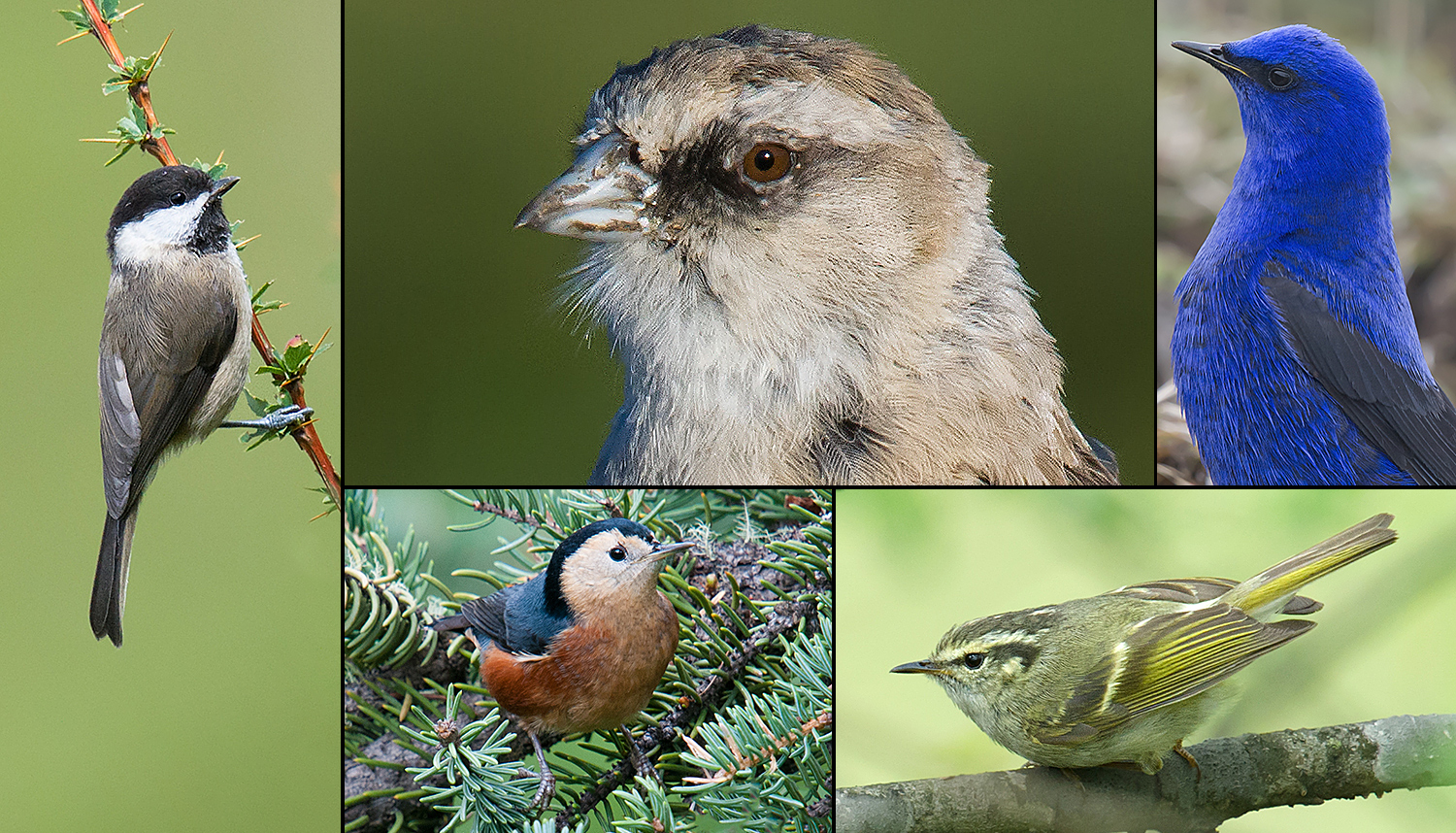
MORE ON SICHUAN
Savor the coverage of Sichuan on shanghaibirding.com and plan your trip to this bird-rich province.
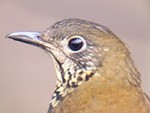
• Indian Blue Robin and Sichuan Thrush at Wolong: Visiting at the height of breeding season, we noted 113 bird species in just four days. Our list reflected the diversity of the region, with eight species of gamebird, eight of chickadee, and nine of leaf warbler. We had sought-after species such as Sichuan Thrush, Indian Blue Robin, and Firethroat.
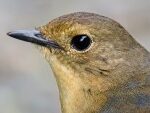
• Rare Photos of Female Firethroat on Old Erlang Road in Sichuan: Relive with Craig Brelsford the process leading up to his attaining the best images of female Firethroat ever taken in the wild. One of the least-known chats in the world, Calliope pectardens is shy, the female particularly so, and photos of the female are extremely rare.
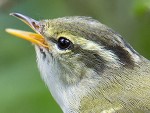
• Expedition to Emeishan & Old Erlang Road: Old Erlang Road yielded Lady Amherst’s Pheasant, Slaty-blue Flycatcher, Claudia’s Leaf Warbler, and a cuckoo seemingly on every tall tree. At Emeishan we had Chestnut-headed Tesia, Grey-hooded Fulvetta, Golden Parrotbill, and White-bellied Redstart.

• Expedition to Sichuan with Jon Hornbuckle: A master trip planner, Jon along with his partners devised an itinerary that netted us some of the most coveted birds of Sichuan. Among them were Wood Snipe, Golden-fronted Fulvetta, Grey-hooded Parrotbill, and Silver Oriole.
Featured image: On his expedition to Sichuan in July 2021, shanghaibirding.com contributor Steven Bonta discovered birds of the Tibetan Plateau. Among them are, clockwise from L, Blood Pheasant Ithaginis cruentus, Giant Laughingthrush Ianthocincla maxima, White-winged Grosbeak Mycerobas carnipes, White-backed Thrush Turdus kessleri, and Przevalski’s Finch Urocynchramus pylzowi. (Craig Brelsford)
Be notified every time we post. Send an
email with “Subscribe” as the subject to
info@shanghaibirding.com
Donate to Shanghai Birding!
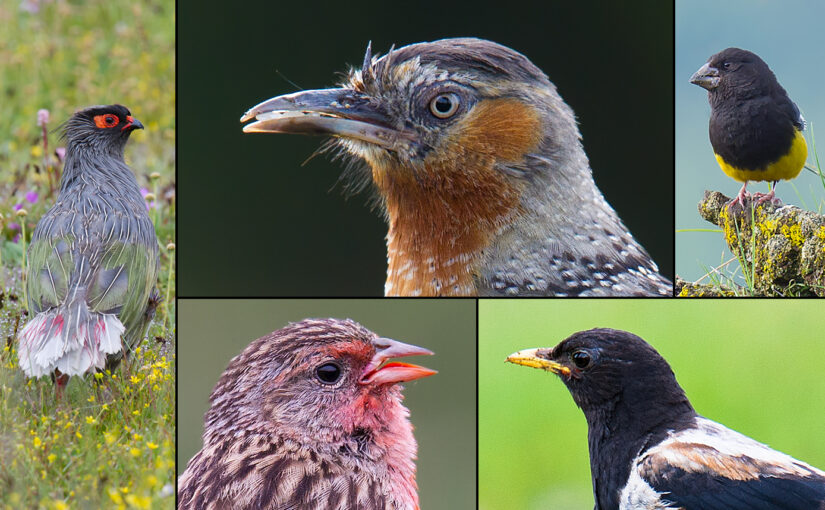

This was from a good time! Nice reading though.